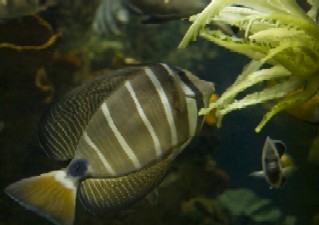Controlling algae growth is a pretty hard task because we actually cannot control algae growth. What we can do is to keep it “under control”.
The two factors that encourage algae growth is light and nutrients. Here are some conditions on how to keep it limited, controlling algae growth.
Light
Algae will actually thrive under low or high intensities of light. Having aquatic plants will help. It will compete for the light and other nutrients.
In most saltwater applications, the lighting intensity will be greater and if there are no competing organisms (corals, anemones), algae has all the light it needs.
Nutrients
Almost all slime algae growth is caused by excessive nutrients. The two main nutrients that you need to control are nitrate and phosphate.
Both of these are end-products of the fish and bacterial digestion of foods. So, the less food we feed, the fewer nitrates and phosphate will accumulate in the aquarium.
Since fish do need to eat, we need to take other approaches to control. Here are some more ways of controlling algae growth.
Feed Your Fish Sparingly!

Feeding your fish is one of the most enjoyable times for the new hobbyist. Since this is the only time we get to interact with our pets, we tend to do it more often during the day. The problems start if there is excess food, which is defined as “overfeeding.” Check out Beginner’s Common Mistakes section of my website to learn more.Overfeeding is the most common source of the algal nutrients ammonia and phosphate. Algae thrive on both the nutrients generated from uneaten food and fish waste.
Control the Lights
Extended light cycle may be encouraging extra algae growth. Putting a timer to replicate a day/night schedule and sticking to that schedule is best.A suggested 10-14 hours per day for planted aquariums and 6-10 for ornamental setups is the most effective in controlling algae, I mean helping to keep it “under control” =).You also need to change your bulbs at least once a year. They lose their spectrum and intensity as they age; this weakened light will likely encourage algae growth.
Frequent Partial Water Changes
Saltwater aquarium requires regular water changes to remove excess nutrients. Ideal frequency is 10% weekly, but for a lightly populated aquarium, 30% monthly is sufficient. It’s also a chance to siphon up all the sludge and dead plant matter in your gravel.
Test your Tap Water
Tap water may contain algae-encouraging elements right out of the faucet. So it is a good practice to test your tap water before changes.
Filter Media Maintenance
Phosphate controlling media is suggested to keep algae’s favorite nutrient out of your aquarium.
Carbon-Phosphate Remover products are also available.The carbon keeps your water crystal clear and removes dissolved organics, the phosphate disappears, and best of all, so does the algae.Use Algae Scrapers
There are convenient algae scrapers available in the market. Mag-Float is one of the popular ones among aquarists. My favorite and the one I would recommend to everybody in this hobby is the Kent Pro Series. They have plastic blades that don’t scratch glass or acrylic aquarium surfaces. Some are made with a long extension so you can scrape away from hard to reach back area of your tank. You can also find a variety of algae scraper’s here:
Add Aquatic Plants
The more plants in your aquarium, the less chance algae has of taking over. Plants compete directly with algae for light and nutrients and most often win if given proper conditions.
Know When Some Algae is OK
Algae may be unsightly, but it actually consumes excess nutrients and provides oxygen. No one “wins” the battle against algae. Success is finding a natural balance in your enclosed ecosystem.
When all is said and done, prevention is the best method of control.
* Disclaimer: Saltwater-Aquarium-Online-Guide.com is a participant in the Amazon Services LLC Associates Program, an affiliate advertising program designed to provide a means for sites to earn advertising fees by advertising and linking to amazon.com, amazon.co.uk, amazon.ca. Amazon and the Amazon logo are trademarks of Amazon.com, Inc. or its affiliates. We may receive a small commission if you click on one of our links and make a purchase. Thank you for supporting Saltwater-Aquarium-Online-Guide.com and helping me make it the best site possible!
Last update on 2024-04-25 / Affiliate links / Images from Amazon Product Advertising API




